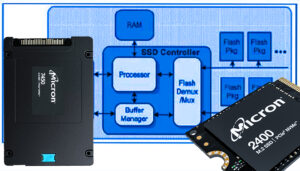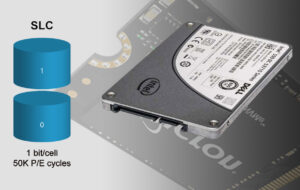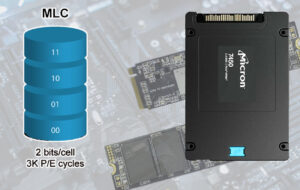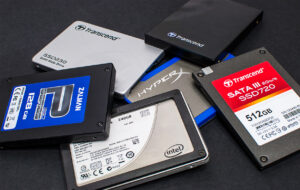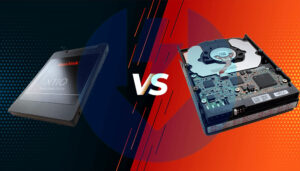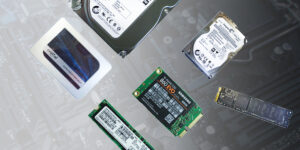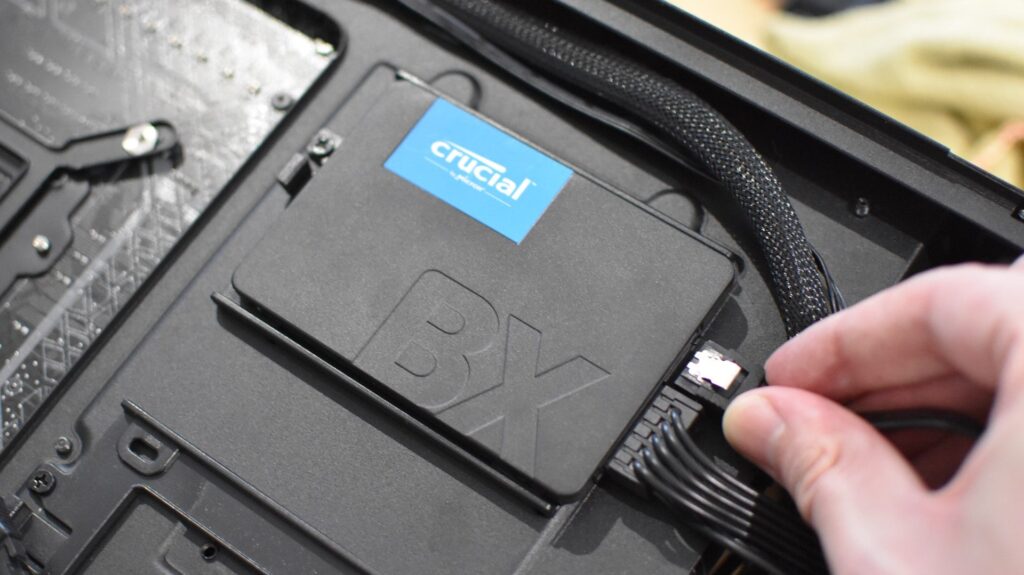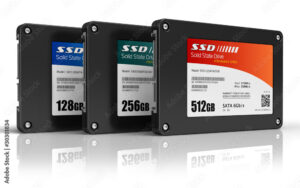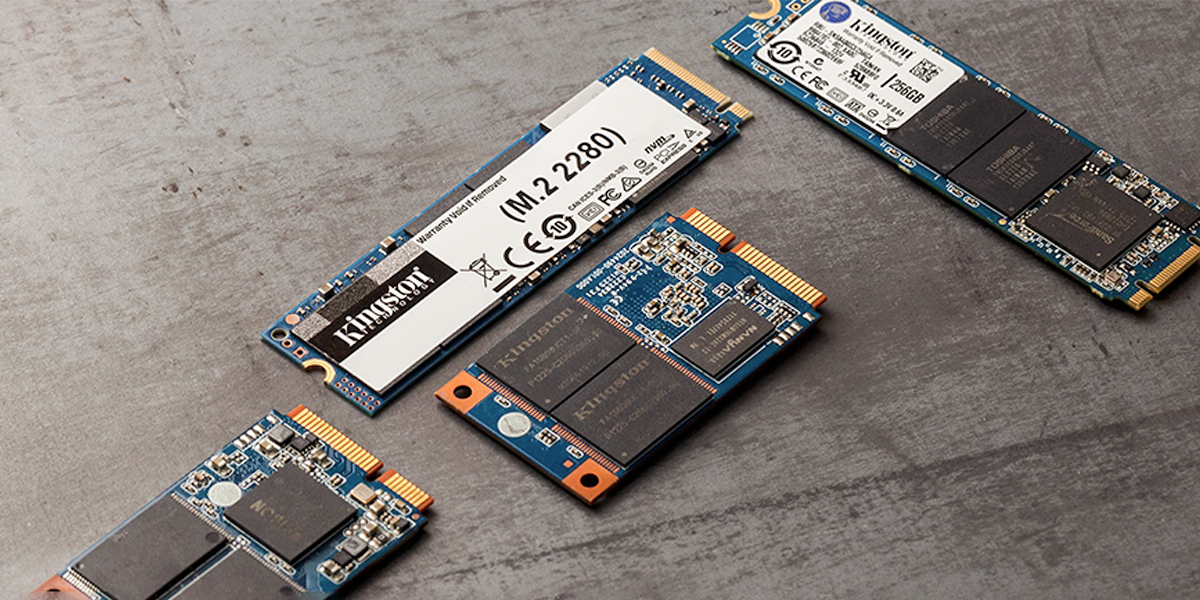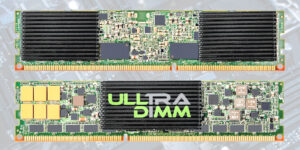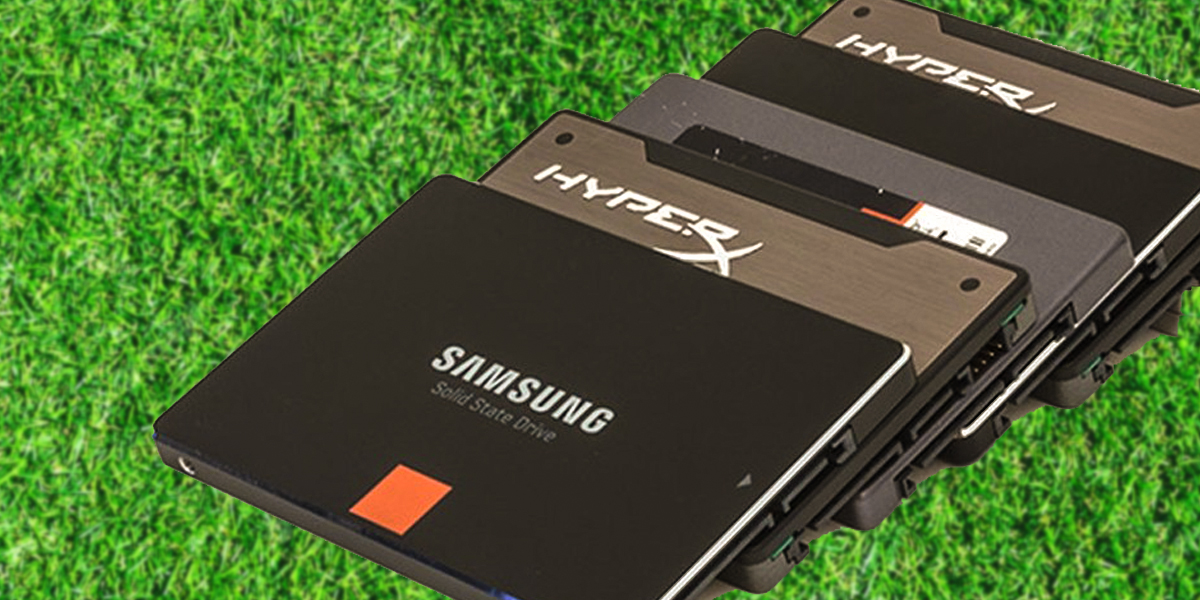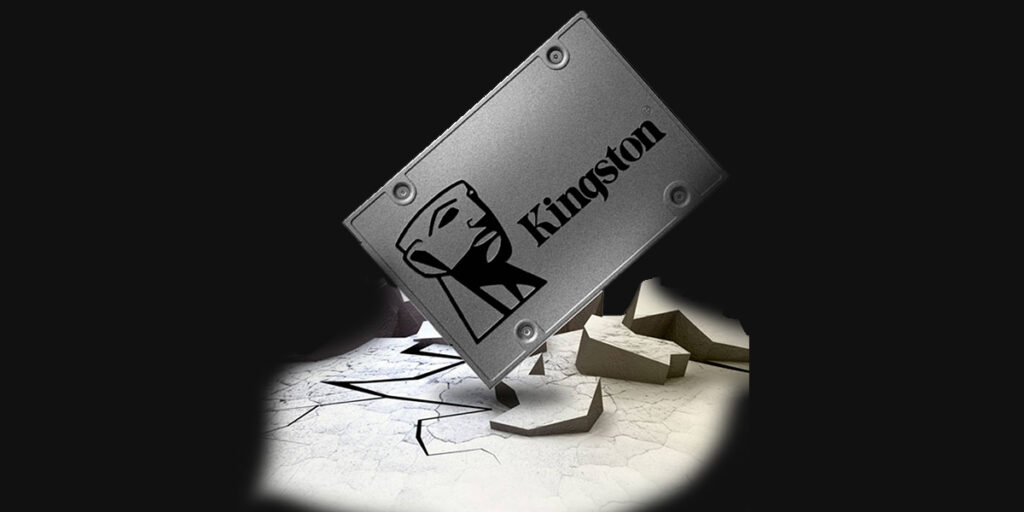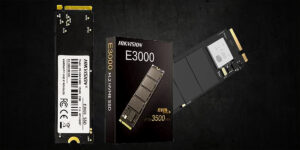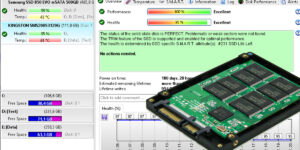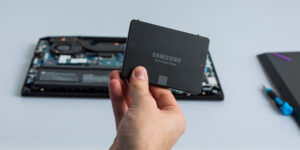What is SSD or Solid-State Drives? A Comprehensive Guide!
Throughout extensive research and analysis from various online sources, including articles, online communities, and personal experiences, I have delved into the world of solid-state drives (SSDs) to comprehend every aspect of this topic.
This exploration aimed to gather comprehensive data and uncover a multitude of insights shared by experts and users alike.
With a wealth of information at hand, I am eager to present my findings and explore the vast realm of SSDs.
An SSD, short for solid-state drive, represents a storage device commonly employed in computers. It diverges from the traditional hard disk drives (HDDs) by leveraging solid-state flash memory as its storage medium.
Unlike HDDs that rely on spinning disks and mechanical components, SSDs utilize non-volatile flash memory, enabling data retention even when disconnected from a power source.
The advantages of SSDs over HDDs are plentiful, with speed being a standout characteristic.
The absence of moving parts in SSDs translates to significantly faster data access and transfer rates. Consequently, devices equipped with SSDs exhibit rapid boot times, accelerated program loading, and expedited file-saving capabilities.
Conversely, conventional hard drives function through magnetically reading and writing data using a spinning disk and a read/write head attached to a mechanical arm known as an actuator.
Unfortunately, the mechanical nature of HDDs renders them susceptible to breakdowns and performance degradation over time.
In stark contrast, SSDs lack movable components that can lead to failures or delays. The core elements of an SSD include the flash controller and NAND flash memory chips.
This purposeful configuration optimizes the drive for high-performance read and write operations, catering to both sequential and random data requests.
The versatility of SSDs allows them to be utilized in a wide array of devices where hard drives are typically deployed. These encompass personal computers (PCs), laptops, gaming consoles, digital cameras, smartphones, tablets, thumb drives, and even graphics cards.
However, it is essential to note that SSDs generally come with a higher price tag compared to traditional HDDs.
The adoption of SSD technology has been driven by businesses facing rapidly expanding I/O (input/output) demands. SSDs’ lower latency enables efficient handling of intensive read and random workloads.
This improved latency stems from the ability of flash SSDs to directly and instantly retrieve data from their stored memory.
High-performance servers, laptops, desktops, and any application requiring real-time data delivery can reap the benefits of solid-state drive technology. Enterprise-grade SSDs prove particularly advantageous in offloading reads from transaction-heavy databases.
Additionally, they help alleviate boot storms in virtual desktop infrastructure and can be integrated into storage arrays to locally store frequently accessed data, capitalizing on the advantages of a hybrid cloud architecture.
In the forthcoming sections, we will embark on a journey to explore the inner workings of SSDs, examine their advantages and disadvantages, delve into various types of SSDs, and uncover further insights.
How do SSDs work?
To understand how SSDs work, let’s delve into their underlying technology and the process by which they read and write data.
Here’s a step-by-step breakdown:
Step#1: Flash Memory:
SSDs rely on interconnected flash memory chips made of silicon.
These chips utilize floating gate transistors (FGTs) that can hold an electrical charge, enabling the SSD to store data even when not connected to a power source.
Step#2: Writing Data:
When data needs to be written to an SSD, the controller sends electrical signals to specific flash memory cells, charging or discharging them to represent the desired data.
This process involves altering the electrical charges in the cells to store the binary information.
Step#3: Reading Data:
To read data from an SSD, the controller measures the electrical charge in the flash memory cells. It interprets the charge levels and determines the corresponding stored data.
This allows the SSD to retrieve the information as needed.
Step#4: Writing Limitations:
Unlike HDDs, SSDs can only write to empty blocks. This limitation ensures optimal performance. Writing to already programmed flash cells is more time-consuming and less efficient.
Step#5: Wear Leveling:
To maximize the lifespan of an SSD, wear leveling is employed.
This technique evenly distributes write operations across all available flash memory cells, preventing certain cells from wearing out faster than others.
Step#6: Garbage Collection:
When a file is deleted or modified, the SSD’s controller marks the corresponding flash memory cells as invalid. In the background, garbage collection consolidates valid data into contiguous blocks.
While Optimizing the use of flash memory and freeing up space for future write operations.
Types of Memory Cells:
SSDs utilize different types of memory cells.
- Single-level cells (SLCs) store one bit of data per cell, providing fast performance and high durability.
- Multi-level cells (MLCs) store two bits per cell, offering higher storage capacity but slightly slower write speeds.
- Triple-level cells (TLCs) store three bits per cell, striking a balance between capacity and cost, although they are slower and less durable than SLCs and MLCs.
In summary, SSDs leverage flash memory chips and advanced controller technology to read and write data. Through techniques like wear leveling and garbage collection, SSDs optimize performance and increase the lifespan of the drive. The use of different types of memory cells allows for a range of options in terms of performance, capacity, and cost.
Types of SSD Non-Volatile Memory
Solid-state drives (SSDs) use different types of non-volatile memory to store data.
Let’s explore the main types of SSD memory:
Single-Level Cells (SLCs):
SLCs are the most basic type of SSD memory. They can store one bit of data per memory cell, represented by a charge or no charge. SLCs offer the fastest read/write speeds, exceptional durability, and a longer lifespan compared to other memory types.
However, SLC-based SSDs are generally more expensive, making them more commonly used in high-performance enterprise and industrial applications.
Multi-Level Cells (MLCs):
MLCs can store two bits of data per memory cell. This higher data density allows MLC-based SSDs to offer greater storage capacities at a more affordable price compared to SLCs.
However, MLCs have slightly slower write speeds and a shorter lifespan due to increased wear and tear on the memory cells.
MLC-based SSDs strike a balance between performance, capacity, and cost, making them suitable for a wide range of consumer and enterprise applications.
Triple-Level Cells (TLCs):
TLCs have the highest data density among the three types of memory cells. They can store three bits of data per memory cell, resulting in even larger storage capacities at a lower cost compared to MLCs.
However, TLCs have slower write speeds, lower endurance, and a shorter lifespan than both SLCs and MLCs. TLC-based SSDs are commonly found in consumer-grade devices and applications that prioritize cost-effective high-capacity storage.
Each type of SSD memory has its trade-offs in terms of performance, endurance, and cost. SLCs provide the best performance and durability but come at a higher cost. MLCs strike a balance between performance and cost, while TLCs offer the highest storage capacity at a lower price but with reduced performance and endurance.
Major Features of SSDs
Solid-state drives (SSDs) possess several features that distinguish them from traditional hard disk drives (HDDs).
Let’s explore the major features of SSDs:
No Moving Parts:
Unlike HDDs that rely on spinning disks and mechanical components, SSDs have no moving parts.
This absence of moving components makes SSDs more resistant to mechanical failures caused by shock, vibration, or accidental drops.
The lack of moving parts also contributes to quieter operation and increased reliability.
Lower Power Consumption:
SSDs consume less power compared to HDDs.
Since SSDs do not require mechanical movements or spin-up time, they use less energy, which results in lower power consumption.
This energy efficiency is particularly beneficial for portable devices such as laptops and tablets, as it extends battery life and reduces the need for frequent recharging.
Quieter Operation:
As SSDs lack spinning disks and moving read/write heads, they operate silently. Unlike HDDs that can produce audible noises during disk rotation or seek operations, SSDs provide a noiseless computing experience.
This feature contributes to a quieter working environment, especially in noise-sensitive settings.
Durability and Shock Resistance:
SSDs are more durable and resistant to physical shock compared to HDDs.
Without moving parts, SSDs are less prone to mechanical failures due to accidental impacts or drops.
This durability makes SSDs suitable for portable devices that are subject to movement or rough handling, as well as for applications in environments with higher levels of vibration or shock.
Predictive Analytics and Drive Failure Detection:
SSDs often incorporate predictive analytics and monitoring capabilities.
These features allow the SSD controller to analyze various parameters, such as temperature, wear levels, and error rates, to detect potential issues and provide advance warnings of drive failure.
This proactive approach helps users take necessary precautions, such as backing up data and replacing the SSD before a complete failure occurs.
Data Reduction Techniques:
SSD controller software includes data reduction techniques such as compression and de-duplication. These techniques help optimize storage capacity by reducing the amount of data that needs to be stored.
By eliminating redundant or repetitive data, SSDs can maximize the available storage space and improve overall efficiency.
Form Factors:
SSDs come in various form factors, allowing them to be compatible with different types of devices and systems. The most common form factor is the 2.5-inch SSD, which is designed to fit into the same slots as traditional HDDs in laptops and desktop computers.
Additionally, there are form factors such as M.2 SSDs and PCIe-based SSDs.
Which provide smaller, more compact options for slim laptops, ultrabooks, and specialized applications.
These major features of SSDs, including their lack of moving parts, lower power consumption, quieter operation, durability, predictive analytics, data reduction techniques, and versatile form factors, contribute to their appeal and suitability for a wide range of computing devices and applications.
Applications of SSDs
SSDs find application in a wide range of devices where storage is needed.
Let’s explore some of the common applications of SSDs.
Personal Computers (PCs):
SSDs are commonly used as the primary storage device in desktop and laptop computers. They offer faster boot times, quicker application launches, and overall improved system responsiveness.
This enhances the user experience by reducing waiting times and providing a smooth computing experience.
Gaming Consoles:
SSDs are increasingly being adopted in gaming consoles due to their ability to significantly reduce game loading times.
With an SSD, game levels and scenes can be loaded faster, allowing gamers to jump into their gaming sessions without delays.
Digital Cameras:
SSDs are employed in professional-grade digital cameras to store high-resolution photos and videos.
The fast data transfer rates of SSDs enable continuous shooting and rapid data recording. Which is ensuring that the photographers can capture important moments without worrying about storage limitations or buffering delays.
Smartphones and Tablets:
SSDs are used as internal storage in high-end smartphones and tablets. They provide faster app installation, smoother multitasking, and quicker access to stored data.
With an SSD, users can launch apps, access media files, and perform various tasks swiftly on their mobile devices.
Data Centers and Servers:
SSDs are extensively utilized in data centers and server environments due to their superior performance and reliability.
They can handle heavy workloads and random data access more efficiently than traditional hard drives.
SSDs enable faster data retrieval and processing, enhancing the overall efficiency of data centers and improving response times for critical applications.
Embedded Systems and IoT Devices:
SSDs are integrated into embedded systems, such as industrial equipment, medical devices, and IoT (Internet of Things) devices.
These devices often require fast and reliable storage to ensure smooth operation and data retention.
SSDs provide the necessary performance and durability for such applications.
Digital Music Players:
Portable music players, such as MP3 players, benefit from the compact size and low power consumption of SSDs.
SSDs provide ample storage capacity for music files, allow quick access to songs, and deliver uninterrupted playback.
Automotive Infotainment Systems:
SSDs are employed in automotive infotainment systems to store multimedia content, navigation data, and other information.
The fast read and write speeds of SSDs ensure quick loading of maps, media files, and system updates, enhancing the overall user experience in the vehicle.
It’s important to note that while SSDs offer numerous benefits, they are generally more expensive compared to traditional hard drives. However, advancements in technology and increasing demand have resulted in more affordable SSD options over time, making them a compelling choice for many applications that require fast and reliable storage.
Advantages of Solid-State Drives (SSDs)
Solid-state drives (SSDs) offer several advantages over traditional hard disk drives (HDDs).
Let’s explore the key benefits of using SSDs:
Faster Read/Write Speeds:
SSDs excel in terms of data access speed.
They can access and retrieve large files much more quickly compared to HDDs.
This results in faster overall system performance, shorter boot times, and reduced loading times for applications and files.
Improved System Responsiveness:
Due to their fast read/write speeds, SSDs significantly enhance the responsiveness of a computer.
Opening programs, launching applications, and performing tasks become nearly instantaneous. Which is providing a smoother and more enjoyable user experience.
Durability and Shock Resistance:
SSDs are more robust and resistant to physical shock and vibration compared to HDDs.
Since they don’t have any moving parts, there’s less risk of mechanical failure or damage caused by accidental drops or jolts.
This makes SSDs ideal for laptops and portable devices.
Lower Power Consumption:
SSDs consume less power compared to HDDs.
The absence of spinning disks and mechanical components results in reduced energy requirements. Which is leading to improved battery life for laptops and lower electricity bills for desktop computers.
Silent Operation:
SSDs operate silently since they don’t have any moving parts that generate noise.
Unlike HDDs, which produce audible sounds due to spinning disks and moving read/write heads, SSDs offer a noiseless computing experience.
Compact Size:
SSDs are typically smaller and lighter than HDDs.
This compact form factor makes them well-suited for slim laptops, ultrabooks, and small form factor PCs.
The reduced size and weight contribute to better portability and flexibility in various computing devices.
Variety of Form Factors:
SSDs come in a variety of form factors, including 2.5-inch drives, M.2 drives, and PCIe-based drives.
This versatility allows for seamless integration into different systems, providing options for upgrading or retrofitting storage in a wide range of devices.
While SSDs offer significant advantages, it’s important to consider their higher cost compared to HDDs. SSDs are generally more expensive per gigabyte of storage. However, the declining prices of SSDs in recent years have made them more accessible and affordable for consumers and businesses alike.
Disadvantages of SSDs
While solid-state drives (SSDs) offer numerous advantages, it’s important to consider their limitations.
Let’s explore the key disadvantages of using SSDs:
Higher Cost:
SSDs are generally more expensive than traditional hard disk drives (HDDs) in terms of cost per gigabyte of storage. The price difference can be significant, especially when considering higher-capacity SSDs.
This higher cost may impact the affordability and feasibility of using SSDs, particularly in scenarios requiring large storage capacities.
Limited Life Expectancy:
SSDs have a limited number of write cycles compared to HDDs. Each flash memory cell in an SSD can only be written to a certain number of times before it becomes unreliable.
While modern SSDs have implemented wear leveling and other techniques to mitigate this limitation. It’s important to be mindful of the lifespan of an SSD, particularly under heavy write-intensive workloads.
Performance Degradation over Time:
The performance of SSDs can degrade over time, especially when dealing with frequent write operations. As an SSD fills up and data is constantly written and erased, the drive may experience slower write speeds and decreased overall performance.
Techniques like garbage collection and TRIM help maintain performance, but it’s essential to monitor an SSD’s performance over its lifespan.
Smaller Storage Options:
SSDs typically offer smaller storage options compared to HDDs at a similar price point. While SSDs with large capacities exist, they are generally more expensive than their HDD counterparts.
This may pose a limitation for users requiring extensive storage space. Such as individuals dealing with large media files or organizations with significant data storage needs.
Data Recovery Challenges:
Recovering data from a malfunctioning or damaged SSD can be more challenging and costly compared to HDDs. In case of data loss or drive failure, specialized data recovery services may be required. And there is no guarantee that all data can be recovered successfully.
Regular backups and data redundancy strategies are crucial to mitigate the risk of data loss.
It’s important to note that the disadvantages of SSDs should be evaluated in the context of specific use cases and requirements.
While SSDs may have limitations, their benefits, such as faster speeds, improved system responsiveness. And durability, often outweigh these drawbacks for many users and applications.
SSD vs. HDD: A Comparison
When it comes to storage devices, solid-state drives (SSDs) and hard disk drives (HDDs) are the two primary options.
Let’s compare SSDs and HDDs to understand their differences:
Speed:
SSDs are significantly faster than HDDs. Since SSDs have no moving parts and rely on flash memory technology, they can access data almost instantly. This results in faster boot times, quicker application launches, and reduced file loading times.
In contrast, HDDs have spinning disks and mechanical read/write heads, which introduce latency and slower data access speeds.
Durability:
SSDs are more durable than HDDs due to their lack of moving parts. HDDs are prone to mechanical failures, as the spinning disks and read/write heads can be sensitive to shocks, vibrations, and physical impacts.
In contrast, SSDs can better withstand physical stress and are less susceptible to damage caused by accidental drops or jolts.
Power Consumption:
SSDs consume less power than HDDs.
Since SSDs do not require energy to spin disks or move mechanical components, they have lower power requirements.
This makes SSDs more energy-efficient, contributing to longer battery life in laptops and reduced electricity consumption in desktop computers.
Noise Level:
SSDs operate silently, while HDDs generate audible noise due to their spinning disks and moving parts. The absence of mechanical components in SSDs eliminates the mechanical noises associated with HDDs, providing a quieter computing experience.
Storage Capacity:
HDDs typically offer larger storage capacities compared to SSDs at a similar price point.
HDDs are available in higher terabyte capacities, making them suitable for users. The users who require extensive storage space for large files, multimedia content, or data-intensive applications.
SSDs, while growing in capacity, generally offer smaller storage options, especially in relation to costlier high-capacity drives.
Price:
HDDs are more affordable than SSDs in terms of cost per gigabyte of storage. This price difference is primarily due to the more complex manufacturing process and advanced technology involved in SSD production.
However, as SSD technology continues to advance and become more mainstream, the price difference has been gradually narrowing.
Fragmentation:
HDDs can suffer from fragmentation, which occurs when files are split and stored in different physical locations on the disk. This fragmentation can impact read/write speeds and overall performance, requiring periodic defragmentation to optimize the drive.
In contrast, SSDs do not experience fragmentation in the same way, as the read speeds remain consistent regardless of the physical location of data on the drive.
In summary, SSDs offer significant advantages over HDDs in terms of speed, durability, power consumption, noise level, and resistance to fragmentation.
However, HDDs still hold an advantage in terms of larger storage capacities at a more affordable price.
When choosing between SSDs and HDDs, it’s important to consider the specific requirements, budget constraints, and priorities of the intended use case to make an informed decision.
SSD Form Factors
Solid-state drives (SSDs) come in different form factors, allowing them to be compatible with various devices and systems.
Let’s explore some common SSD form factors:
2.5-inch SSD:
The 2.5-inch SSD is one of the most prevalent form factors. It shares the same size and shape as traditional laptop hard disk drives (HDDs). This compatibility enables easy replacement of HDDs with SSDs in laptops and desktop computers without requiring any modifications.
The 2.5-inch SSDs are available in different heights to accommodate various storage capacities.
M.2 SSD:
M.2 SSDs are smaller and more compact than 2.5-inch SSDs. They are commonly used in ultrabooks, tablets, and small form factor devices where space is limited. M.2 SSDs connect directly to the motherboard using the M.2 slot, eliminating the need for cables or connectors.
These SSDs can come in different lengths, typically ranging from 42 millimeters (mm) to 110 mm, making them versatile for different system configurations.
PCIe-based SSD:
Peripheral Component Interconnect Express (PCIe)-based SSDs provide higher performance compared to SATA-based SSDs. They connect to the PCIe slot on the motherboard, offering faster data transfer rates and lower latency.
PCIe-based SSDs are commonly used in high-performance desktops, workstations, and servers that require exceptional storage performance.
U.2 SSD:
U.2 SSDs, formerly known as SFF-8639, are 2.5-inch SSDs that use the U.2 interface. These SSDs leverage the NVMe (Non-Volatile Memory Express) protocol and can be inserted into a computer’s circuit board without the need to power down the system.
U.2 SSDs provide high-speed NVMe-based PCIe storage, making them suitable for enterprise applications and high-performance storage solutions.
DIMM-based SSD:
DIMM-based SSDs, also known as NVDIMMs (Non-Volatile Dual In-line Memory Modules), combine flash storage with dynamic random-access memory (DRAM). These modules fit into DIMM slots on the motherboard, providing a unique storage solution that offers low latency and high-speed data access.
DIMM-based SSDs are primarily used in specific enterprise applications that require ultra-fast storage for critical workloads.
Custom Form Factors:
SSDs also come in custom form factors designed for specific devices or systems. For example, some SSDs are specifically tailored for use in ruggedized computers, industrial equipment, or specialized applications. Where durability, temperature resistance, or specific size requirements are essential.
The variety of SSD form factors allows for flexibility and compatibility with different devices and system architectures. It’s important to consider the specific form factor requirements of the target device or system when selecting an SSD to ensure proper fit and integration.
SSD Manufacturers
Several manufacturers specialize in producing solid-state drives (SSDs).
Let’s explore some of the prominent SSD manufacturers:
Crucial:
Crucial is a well-known brand that offers a wide range of SSDs for both consumer and enterprise markets. Their SSDs are recognized for their reliability, performance, and competitive pricing.
Crucial SSDs come in various form factors and capacities to suit different computing needs.
Intel:
Intel, a leading technology company, produces SSDs known for their high performance and durability. Intel SSDs are designed to deliver fast data access speeds and excellent reliability.
They offer a range of SSDs suitable for consumer PCs, laptops, and enterprise-level applications.
Kingston Technology:
Kingston Technology is a popular manufacturer of memory and storage solutions, including SSDs. Kingston SSDs are known for their reliability, affordability, and solid performance.
They offer a range of SSDs with different form factors and capacities to meet the needs of various users.
Micron Technology Inc.:
Micron Technology is a global leader in memory and storage solutions, manufacturing a wide range of SSDs. Micron SSDs are renowned for their high performance, efficiency, and advanced features.
They cater to both consumer and enterprise markets, providing reliable and innovative storage solutions.
Samsung:
Samsung is a prominent player in the SSD market, offering a diverse lineup of SSDs renowned for their speed and performance.
Samsung SSDs utilize advanced technologies and deliver exceptional read/write speeds, making them highly sought after by consumers and professionals alike.
SanDisk:
SanDisk, a Western Digital brand, is a renowned manufacturer of flash memory products, including SSDs. SanDisk SSDs are known for their reliability, speed, and compatibility.
They offer a range of SSDs for different applications, including consumer devices, gaming systems, and data center environments.
Seagate Technology:
Seagate Technology, a leading data storage company, also produces SSDs alongside their traditional HDD offerings. Seagate SSDs provide fast data access, reliability, and power efficiency.
They cater to a wide range of users, from individual consumers to enterprise customers.
These manufacturers have established themselves as leaders in the SSD market, consistently delivering quality products that meet the demands of various users and applications. When considering an SSD, it’s important to review the specifications, performance, and customer reviews to find the most suitable SSD from a reliable manufacturer.
Types of SSD Non-Volatile Memory
Solid-state drives (SSDs) use different types of non-volatile memory to store data.
Let’s explore the three main types of memory used in SSDs:
Single-Level Cells (SLCs):
Single-level cells can store one bit of data per cell, representing either a 1 or a 0. SLCs offer the fastest read/write speeds and highest durability among the three memory types.
While SLC-based SSDs are the most expensive. They are well-suited for applications that require exceptional performance and reliability, such as high-end servers or professional workstations.
Multi-Level Cells (MLCs):
Multi-level cells can store two bits of data per cell, effectively doubling the data density compared to SLCs. MLC-based SSDs provide a balance between performance and cost-effectiveness.
They offer larger storage capacities at a lower price point, making them suitable for a wide range of consumer and enterprise applications.
However, MLCs generally have slightly slower write speeds compared to SLCs.
Triple-Level Cells (TLCs):
Triple-level cells can store three bits of data per cell, further increasing data density. TLC-based SSDs offer even greater storage capacities at more affordable prices compared to MLCs. However, TLCs have slower write speeds and lower durability due to the increased complexity of storing multiple bits in each cell.
TLC-based SSDs are commonly used in consumer devices like laptops, tablets, and consumer-grade desktops.
It’s important to note that as the number of bits per cell increases (from SLC to MLC to TLC), the durability and write speeds of the SSD may be affected.
However, advancements in technology and improvements in flash memory manufacturing have led to the development of techniques and algorithms that mitigate these concerns to a great extent.
SSD Form Factors
Solid-state drives (SSDs) come in different form factors to accommodate various devices and systems.
Let’s explore some common SSD form factors:
2.5-inch SSD:
The 2.5-inch SSD is one of the most popular form factors, commonly used in laptops, desktops, and external storage devices. It has the same size and shape as traditional laptop hard disk drives (HDDs), allowing for easy replacement or upgrading of storage.
2.5-inch SSDs are available in different capacities and thicknesses to suit different storage needs.
M.2 SSD:
M.2 SSDs are small, compact, and versatile form factors used in modern devices like ultrabooks, tablets, and slim desktops. They connect directly to the motherboard using the M.2 slot, eliminating the need for cables or connectors.
M.2 SSDs are available in various lengths and widths, providing flexibility for different system configurations.
PCIe-based SSD:
PCIe-based SSDs are designed to connect directly to the PCIe (Peripheral Component Interconnect Express) slot on the motherboard. They offer higher performance and faster data transfer speeds compared to SATA-based SSDs.
PCIe-based SSDs are commonly used in gaming PCs, workstations, and high-performance computing systems.
U.2 SSD:
U.2 SSDs, also known as SFF-8639, are 2.5-inch SSDs that use the U.2 interface. They provide high-speed NVMe (Non-Volatile Memory Express) storage and are primarily used in enterprise environments and data centers.
U.2 SSDs offer a balance between performance, capacity, and compatibility with existing infrastructure.
mSATA SSD:
mSATA (mini-SATA) SSDs are smaller form factor drives designed for space-constrained devices such as ultrabooks and small form factor PCs.
They connect using the mSATA slot on the motherboard and provide a compact storage solution without sacrificing performance.
NVMe SSD:
NVMe (Non-Volatile Memory Express) SSDs are designed specifically for high-performance applications that require lightning-fast data transfer speeds. They use the NVMe interface to communicate with the system, enabling ultra-low latency and high bandwidth.
NVMe SSDs are commonly used in high-end workstations, gaming rigs, and enterprise servers.
These are just a few examples of SSD form factors available in the market. It’s important to consider the compatibility and requirements of your device or system when selecting an SSD form factor. SSDs offer flexibility in terms of size, performance, and compatibility, allowing users to choose the most suitable form factor for their specific needs.
Major SSD Features
Solid-state drives (SSDs) possess several notable features that set them apart from traditional hard disk drives (HDDs).
Let’s explore some of the major features of SSDs:
No Moving Parts:
Unlike HDDs, which consist of spinning disks and mechanical read/write heads, SSDs have no moving parts. This absence of mechanical components contributes to their increased durability and reliability.
Without moving parts, SSDs are less prone to mechanical failures caused by vibrations or physical impacts.
Fast Access Speeds:
SSDs offer faster access speeds compared to HDDs. They provide rapid data retrieval, resulting in quicker system boot times and faster application loading.
This speed advantage allows users to access files and launch programs with minimal delay, enhancing overall system performance and responsiveness.
Low Power Consumption:
SSDs are more energy-efficient than HDDs. As they do not require power to spin disks or move mechanical parts, SSDs consume less power during operation.
This energy efficiency is particularly advantageous for laptops and other portable devices, as it helps extend battery life and reduce power consumption.
Silent Operation:
Since SSDs lack moving parts, they operate silently. Unlike HDDs that produce audible noise due to spinning disks and mechanical activity, SSDs provide a noiseless computing experience.
This feature is especially appreciated in quiet environments or when using devices such as ultrabooks or home theater PCs.
Compact Size and Lightweight:
SSDs are compact and lightweight, making them ideal for devices with limited space or those requiring portability. Their smaller form factors allow for easy integration into slim laptops, tablets, and other space-constrained devices.
Additionally, the reduced weight contributes to lighter and more portable devices.
Predictive Analytics and Data Reduction:
SSDs often incorporate predictive analytics features that can detect potential drive failures in advance. This early warning system alerts users to take necessary backup measures to prevent data loss.
Additionally, SSDs employ data reduction techniques, such as compression and de-duplication, to optimize storage capacity and enhance overall efficiency.
Understanding these major features helps users appreciate the benefits that SSDs offer in terms of durability, speed, power efficiency, silent operation, compactness, and advanced features like predictive analytics and data reduction. SSDs continue to evolve, pushing the boundaries of storage technology and providing enhanced performance for various computing applications.
Advantages of SSDs over HDDs
Solid-state drives (SSDs) offer several advantages over traditional hard disk drives (HDDs).
Let’s explore these advantages:
Faster Read/Write Speeds:
SSDs provide significantly faster read/write speeds compared to HDDs. This means that data can be accessed and transferred more quickly, resulting in faster boot times, reduced application loading times, and improved overall system responsiveness.
Tasks such as opening files, launching programs, and performing system operations can be completed faster with an SSD.
Improved Performance:
Due to their faster read/write speeds, SSDs offer improved overall performance compared to HDDs. Applications run smoother and are more responsive, resulting in a better user experience.
Whether you’re playing games, editing videos, or working on complex projects, SSDs can handle demanding tasks more efficiently.
Durability and Reliability:
SSDs are more durable and reliable than HDDs. Since they have no moving parts, SSDs are less susceptible to mechanical failures caused by shocks, vibrations, or accidental drops.
This makes them more resistant to physical damage, increasing their lifespan and reliability.
Energy Efficiency:
SSDs consume less power than HDDs, making them more energy-efficient. As they don’t have spinning disks or moving parts that require continuous power, SSDs use less electricity.
This is particularly beneficial for laptops and portable devices, as it helps to extend battery life and reduce energy consumption.
Noiseless Operation:
SSDs operate silently because they don’t have moving parts that generate noise. Unlike HDDs that produce sound due to spinning disks and mechanical activity, SSDs provide a quiet computing experience.
This is advantageous in noise-sensitive environments or when working on tasks that require concentration.
Compact Size and Lightweight:
SSDs are smaller and lighter than HDDs, making them suitable for devices with limited space or those that prioritize portability. The compact size of SSDs allows for slimmer and more lightweight laptops, ultrabooks, and other portable devices.
This makes SSDs an ideal choice for users who value mobility without sacrificing storage capacity.
Less Heat Generation:
SSDs generate less heat compared to HDDs. As there are no mechanical components that create friction and heat, SSDs operate at lower temperatures.
This reduces the need for extensive cooling systems in devices, leading to better overall system efficiency and potentially prolonging the lifespan of other components.
By considering these advantages, it’s clear that SSDs provide significant benefits in terms of speed, performance, durability, energy efficiency, noiseless operation, compactness, and heat generation. These advantages have made SSDs increasingly popular and desirable for both personal and professional computing applications.
SSDs vs. eMMC, A Camparision!
When it comes to storage technologies, two common options are solid-state drives (SSDs) and embedded Multi Media Cards (eMMC).
Let’s compare the differences between SSDs and eMMC:
Performance:
SSDs offer superior performance compared to eMMC.
SSDs utilize advanced flash memory and high-speed interfaces like SATA or PCIe, resulting in faster data transfer speeds and quicker access times. This makes them ideal for demanding tasks such as gaming, multimedia editing, and software development.
On the other hand, eMMC, which is typically found in budget-friendly devices. It provides slower read and write speeds, making it better suited for basic computing needs.
Like web browsing, document editing, and media consumption.
Storage Capacity:
SSDs generally offer larger storage capacities compared to eMMC.
SSDs are available in various sizes ranging from a few hundred gigabytes to multiple terabytes, accommodating extensive data storage requirements. In contrast, eMMC storage is typically more limited, ranging from 8GB to 256GB.
While sufficient for everyday use, the limited capacity of eMMC may require users to rely on external storage options or cloud services for additional storage needs.
Device Compatibility:
SSDs are compatible with a wide range of devices, including laptops, desktops, servers, and gaming consoles. They can be easily installed or upgraded in most systems, offering flexibility and compatibility across different platforms.
On the other hand, eMMC is primarily used in mobile devices like smartphones, tablets, and low-power laptops.
The embedded nature of eMMC makes it challenging to replace or upgrade, as it is directly integrated into the device’s motherboard.
Endurance and Lifespan:
SSDs generally have higher endurance and a longer lifespan compared to eMMC.
SSDs are designed with advanced wear-leveling algorithms and technologies to distribute data writes evenly across the drive, minimizing wear on individual memory cells.
This results in better longevity and durability, making SSDs suitable for heavy read/write workloads.
While eMMC can withstand regular daily use, it may have a shorter lifespan due to its lower endurance rating and limited write cycles.
Price:
SSDs tend to be more expensive than eMMC storage. The higher cost of SSDs reflects their superior performance, larger capacities, and advanced technologies.
eMMC, being a budget-friendly option, offers a more cost-effective storage solution. Which makes it popular in entry-level devices where cost considerations play a significant role.
In summary, SSDs excel in terms of performance, storage capacity, compatibility, endurance, and lifespan, making them the preferred choice for high-performance computing. eMMC, on the other hand, is commonly found in budget-friendly devices and serves well for basic computing needs.
When selecting between SSDs and eMMC, it’s essential to consider the specific requirements of the device, balancing performance needs with budget constraints.
SSDs vs. Hybrid Hard Drives (HHDs)
When comparing storage options, two common choices are solid-state drives (SSDs) and hybrid hard drives (HHDs).
Let’s explore the differences between SSDs and HHDs:
Speed and Performance:
SSDs offer faster data access and transfer speeds compared to HHDs. With no moving parts, SSDs provide near-instantaneous access to data, resulting in quicker system boot times and faster application loading.
On the other hand, HHDs combine the features of both SSDs and traditional HDDs, utilizing a small amount of flash memory as a cache alongside a traditional spinning disk.
While HHDs can provide some performance benefits by caching frequently accessed data, they still fall short of the speed offered by SSDs.
Data Storage:
SSDs typically offer lower storage capacities compared to HHDs. SSDs are available in various sizes, ranging from a few hundred gigabytes to multiple terabytes. They are ideal for users who prioritize speed and responsiveness over sheer storage capacity.
HHDs, on the other hand, provide larger storage capacities by utilizing the traditional HDD component. Which makes them suitable for users who require extensive storage space for large files and multimedia content.
Cost:
HHDs are generally more cost-effective compared to SSDs, especially when considering larger storage capacities. SSDs tend to be more expensive per gigabyte of storage due to their advanced technology and faster performance.
HHDs provide a balance between storage capacity and cost, making them an attractive option for users with budget constraints who still desire a significant amount of storage.
Durability and Reliability:
SSDs are more durable and reliable than HHDs.
Since SSDs have no moving parts, they are less susceptible to mechanical failures caused by shocks, vibrations, or accidental drops. In contrast, HHDs contain mechanical components, including spinning disks and read/write heads, which can be more vulnerable to physical damage.
This makes SSDs a more reliable option, especially in environments where durability is critical.
Power Efficiency:
SSDs consume less power compared to HHDs. As they don’t require power to spin disks or move mechanical parts, SSDs are more energy-efficient. They help extend battery life in laptops and reduce power consumption in desktop systems.
HHDs, with their traditional spinning disks, consume more power due to the constant rotation of the drive platters.
Wrap Up
SSDs excel in terms of speed, reliability, and power efficiency, making them ideal for users who prioritize performance and durability. HHDs, with their larger storage capacities and cost-effectiveness, are a suitable choice for users who require extensive storage at a more affordable price point. Ultimately, the decision between SSDs and HHDs depends on individual needs, balancing factors such as speed, capacity, reliability, and budget considerations.
In conclusion, solid-state drives (SSDs) have revolutionized the storage landscape, offering significant advantagespp over traditional hard disk drives (HDDs). SSDs provide faster read/write speeds, improved overall performance, enhanced durability, and energy efficiency. With no moving parts, SSDs are less prone to mechanical failures and operate silently, offering a noiseless computing experience. Their compact size and lightweight nature make them ideal for portable devices. Additionally, SSDs offer features like predictive analytics, data reduction techniques, and a variety of form factors to cater to diverse needs.
Comparing SSDs with other storage technologies, we see that they outperform embedded MultiMediaCards (eMMC) in terms of performance and storage capacity. Similarly, when compared to hybrid hard drives (HHDs), SSDs offer faster speeds, increased durability, and greater power efficiency. However, HHDs still maintain an advantage in terms of cost-effectiveness and larger storage capacities.
As SSD technology continues to advance, prices have become more affordable, making them a viable choice for both personal and professional users. Whether it’s for gaming, multimedia editing, or everyday computing, SSDs provide a reliable and efficient storage solution.
Ultimately, the choice between SSDs and other storage options depends on individual requirements, including speed, storage capacity, reliability, budget, and specific use cases. As technology evolves, SSDs are expected to further dominate the storage landscape, providing faster and more reliable storage solutions for a wide range of applications.






